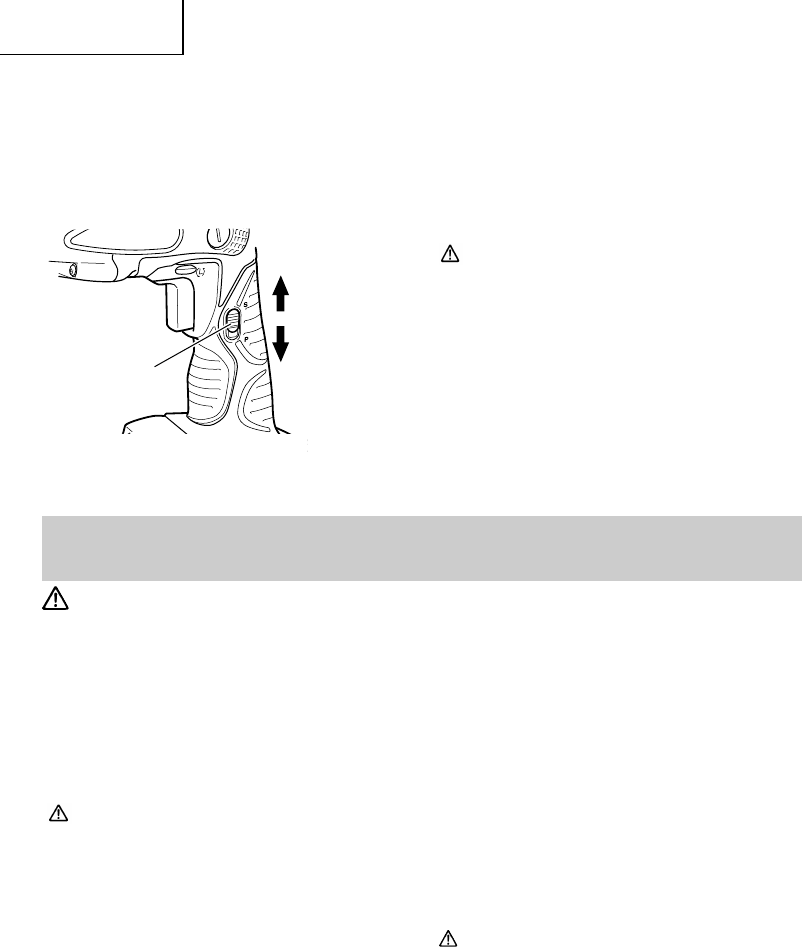
English
18
8. Switching between the “SAVE“ and the “POWER“
modes
The hammering force of the hammer can be
increased or decreased to conform with intended
usage, by operating the shift knob as per Fig. 25.
Adjust the force to match the usage intended.
Shift knob
“POWER“ mode
“SAVE“ mode
Fig. 25
(1) “SAVE“ mode ... decreased hammering force
This can prevent thin drill bits which are less than
4.3 mm in diameter, from being bent or broken.
(2) “POWER“ mode ... increased hammering force
⅜
This can be used to speedily and efficiently drill
holes when the drill bits which are being used are
greater than 4 mm in diameter.
⅜
This can be used to drill holes into wood or metal.
CAUTION:
Do not drill holes in wood with the “SAVE“ mode.
There is a likelihood that the motor will burn out
because it can easily lock up due to the low power.
MAINTENANCE AND INSPECTION
CAUTION:
Pull out battery before doing any inspection or maintenance.
1. Inspecting the drill bits
Since use of a dull tool will cause motor
malfunctioning and degraded efficiency, replace
the drill bit with a new one or resharpening without
delay when abrasion is noted.
2. Check the Screws
Loose screws are dangerous. Regularly inspect
them and make sure they are tight.
CAUTION:
Using this power tool with loosened, screws is
extremely dangerous.
3. Maintenance of the motor
The motor unit winding is the very “heart” of the
power tool.
Exercise due care to ensure the winding does not
become damaged and/or wet with oil or water.
4. Inspecting the carbon brushes (Fig. 17)
The motor employs carbon brushes which are
consumable parts. Since and excessively worn
carbon brush can result in motor trouble, replace
the carbon brush with new ones when it becomes
worn to or near the “wear limit”. In addition,
always keep carbon brushes clean and ensure that
they slide freely within the brush holders.
NOTE:
When replacing the carbon brush with a new one,
be sure to use the Hitachi Carbon Brush Code No.
328481.
5. Replacing carbon brushes
Take out the carbon brush by first removing the
brush cap and then hooking the protrusion of the
carbon brush with a flat head screw driver, etc., as
shown in Fig. 18.
When installing the carbon brush, choose the
direction so that the nail of the carbon brush agrees
with the contact portion outside the brush tube.
Then push it in with a finger as illustrated in Fig.
19. Lastly, install the brush cap.
CAUTION:
●
Be absolutely sure to insert the nail of the carbon
brush into the contact portion outside the brush
tube. (You can insert whichever one of the two
nails provided.)
●
Caution must be exercised since any error in this
operation can result in the deformed nail of the
carbon brush and may cause motor trouble at an
early stage.
01Eng_DH18DL_US 12/12/07, 19:0118


















